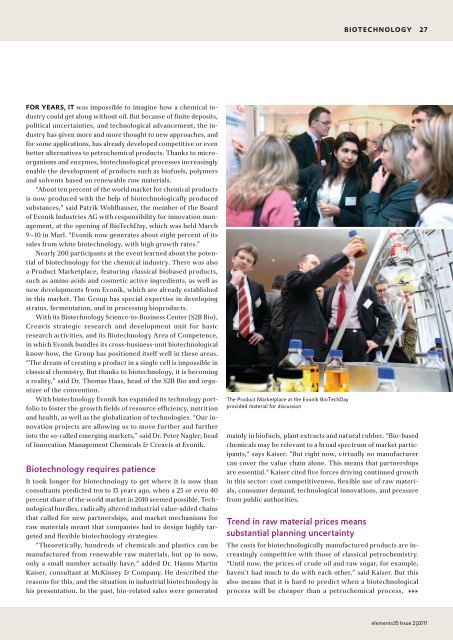Download - Evonik Industries
Download - Evonik Industries
Download - Evonik Industries
You also want an ePaper? Increase the reach of your titles
YUMPU automatically turns print PDFs into web optimized ePapers that Google loves.
foR YeARs, It was impossible to imagine how a chemical industry<br />
could get along without oil. But because of finite deposits,<br />
political uncertainties, and technological advancement, the industry<br />
has given more and more thought to new approaches, and<br />
for some applications, has already developed competitive or even<br />
better alternatives to petrochemical products. Thanks to microorganisms<br />
and enzymes, biotechnological processes increasingly<br />
enable the development of products such as biofuels, polymers<br />
and solvents based on renewable raw materials.<br />
“About ten percent of the world market for chemical products<br />
is now produced with the help of biotechnologically produced<br />
substances,” said Patrik Wohlhauser, the member of the Board<br />
of <strong>Evonik</strong> <strong>Industries</strong> AG with responsibility for innovation management,<br />
at the opening of BioTechDay, which was held March<br />
9–10 in Marl. “<strong>Evonik</strong> now generates about eight percent of its<br />
sales from white biotechnology, with high growth rates.”<br />
Nearly 200 participants at the event learned about the potential<br />
of biotechnology for the chemical industry. There was also<br />
a Product Marketplace, featuring classical biobased products,<br />
such as amino acids and cosmetic active ingredients, as well as<br />
new developments from <strong>Evonik</strong>, which are already established<br />
in this market. The Group has special expertise in developing<br />
strains, fermentation, and in processing bioproducts.<br />
With its Biotechnology Science-to-Business Center (S2B Bio),<br />
Creavis strategic research and development unit for basic<br />
research activities, and its Biotechnology Area of Competence,<br />
in which <strong>Evonik</strong> bundles its cross-business-unit biotechnological<br />
know-how, the Group has positioned itself well in these areas.<br />
“The dream of creating a product in a single cell is impossible in<br />
classical chemistry. But thanks to biotechnology, it is becoming<br />
a reality,” said Dr. Thomas Haas, head of the S2B Bio and organizer<br />
of the convention.<br />
With biotechnology <strong>Evonik</strong> has expanded its technology portfolio<br />
to foster the growth fields of resource efficiency, nutrition<br />
and health, as well as the globalization of technologies. “Our innovation<br />
projects are allowing us to move further and further<br />
into the so-called emerging markets,” said Dr. Peter Nagler, head<br />
of Innovation Management Chemicals & Creavis at <strong>Evonik</strong>.<br />
Biotechnology requires patience<br />
It took longer for biotechnology to get where it is now than<br />
consultants predicted ten to 15 years ago, when a 25 or even 40<br />
percent share of the world market in 2010 seemed possible. Technological<br />
hurdles, radically altered industrial value-added chains<br />
that called for new partnerships, and market mechanisms for<br />
raw materials meant that companies had to design highly targeted<br />
and flexible biotechnology strategies.<br />
“Theoretically, hundreds of chemicals and plastics can be<br />
man ufactured from renewable raw materials, but up to now,<br />
only a small number actually have,“ added Dr. Hanns Martin<br />
Kaiser, consultant at McKinsey & Company. He described the<br />
reasons for this, and the situation in industrial biotechnology in<br />
his presentation. In the past, bio-related sales were generated<br />
The Product Marketplace at the <strong>Evonik</strong> BioTechDay<br />
provided material for discussion<br />
BIoteCHnoLoGY 27<br />
mainly in biofuels, plant extracts and natural rubber. “Bio-based<br />
chemicals may be relevant to a broad spectrum of market participants,“<br />
says Kaiser. “But right now, virtually no manufacturer<br />
can cover the value chain alone. This means that partnerships<br />
are essential.“ Kaiser cited five forces driving continued growth<br />
in this sector: cost competitiveness, flexible use of raw materials,<br />
consumer demand, technological innovations, and pressure<br />
from public authorities.<br />
Trend in raw material prices means<br />
substantial planning uncertainty<br />
The costs for biotechnologically manufactured products are increasingly<br />
competitive with those of classical petrochemistry.<br />
“Until now, the prices of crude oil and raw sugar, for example,<br />
haven’t had much to do with each other,” said Kaiser. But this<br />
also means that it is hard to predict when a biotechnological<br />
process will be cheaper than a petrochemical process, 333<br />
elements35 Issue 2|2011
















